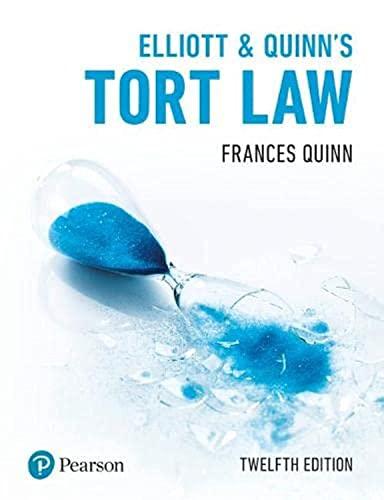Answered step by step
Verified Expert Solution
Question
1 Approved Answer
1. A sophisticated client is confident, knowledgeable and very up to date. o True o False 2. The law protects you from people who try
1. A sophisticated client is confident, knowledgeable and very up to date. o True o False 2. The law protects you from people who try to take advantage of you. o True o False 3. The law is sophisticated. o True o False 4. The business decisions can't be made without studying a business law. o True o False 5. Business owner makes many business decisions to run his business successfully. o True o False 6. The small courts deal with the claims exceeding to $35,000.00 claims. o True o False 7. Law is the body of rules made by government that can be enforced by courts or government agencies. o True o False 8. Canadian courts are not open to the public. o True o False 9. Defamation is a published statement that is to a person's detriment. o True o False 10. The law of torts involves private disputes decided in the civil court. o True o False 11. A tort is committed when one person causes injury to another, harming his or her person, property, or reputation. o True o False 12. A plaintiff is a person who defends the claim. o True o False 13. Insurance is taken to spread the risk of loss. o True o False 14. A contract is not a binding on each party. o True o False 15. A contract is an exchange of promises not enforceable in court. o True o False 16. A creditor is bound by her promise to take less in full satisfaction of the debt. o True o False 17. A contract must always be in writing. o True o False 18. All contracts that restrain trade are illegal. o True o False 19. Verbal contracts are not valid in the court of law. o True o False 20. Misrepresentation in the contract is not punishable act. o True o False 21. A contract is not a time bound document. o True o False 22. It is not necessary to have at least two parties to make a contract. o True o False 23. Discharge of contract can come to an end through performance, breach, agreement, or frustration. o True o False 24. When the decision making is left in the hands of the disputing parties to work out for themselves is called mediation. o True o False 25. When a third party makes a binding decision in the matter under dispute is called arbitration. o True o False 26. When a neutral third party assists the parties in coming to a resolution on their own is called negotiation. o True o False 27. Debtor has the right to be notified of sale and to redeem the property before it is sold by the bank. o True o False 28. A guarantee is a contingent liability in which someone agrees to be responsible when a debtor fails to pay. o True o False o False 29. Chattels mean tangible and movable property. o True o False 30. Fixtures are not the permanent part of a property. o True o False 31. The corporation is not a separate legal entity. o True o False 32. A sole proprietorship consists of two or more partners. o True o False 33. Sole proprietor has limited liabilities of a business. o True o False 34. The law does not protect you from people who try to take advantage of you. o True o False 35. The terms of contract simply refer to promises made by one party to another party by virtue of offer and acceptance. In this way, contractual terms provide a blueprint of what the parties have obligated themselves to do. o True o False 36. A provision that is not expressly included in a contract but that is necessary to give effect to the parties' intention will not become part of the contract. o True o False 37. A basic feature of the Canadian political system is the principle that individuals should be subject to know, predicable, and impartial rules rather than the arbitrary orders of those in governing positions. This principal is commonly referred to as; a). Rule of law b). Equity c). The charter of Rights and freedoms d). Lineal democracy 38. Laws that have been passed by an act of Parliament of a provincial legislation are most broadly conceptualized as which type of law: a). Statutory law b). Constitutional law c). Administrative law d). Common law
Step by Step Solution
There are 3 Steps involved in it
Step: 1

Get Instant Access to Expert-Tailored Solutions
See step-by-step solutions with expert insights and AI powered tools for academic success
Step: 2

Step: 3

Ace Your Homework with AI
Get the answers you need in no time with our AI-driven, step-by-step assistance
Get Started


